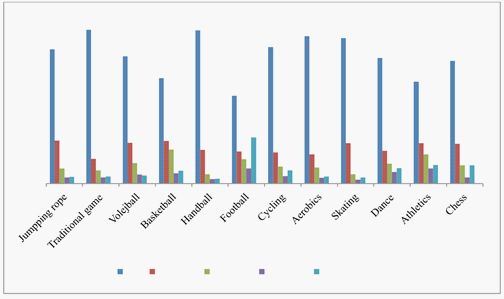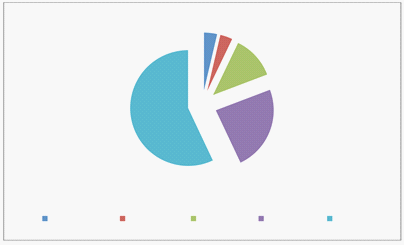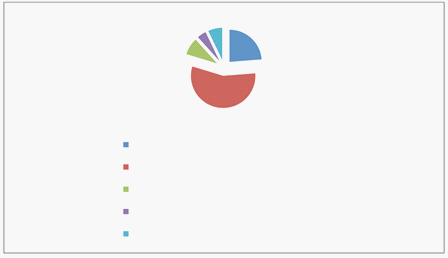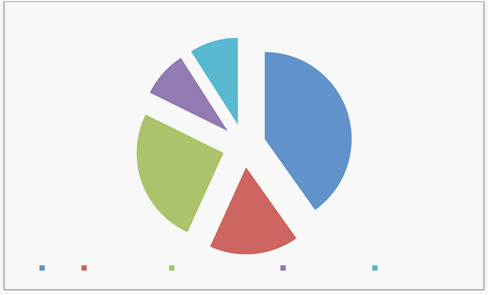The Measurement of Albanian Children’s Physical Activity during Their Leisure Time and Physical Education Class
Abstract
Regular leisure time P.A plays a significant role in increasing children’s overall P.A, regardless of whether this takes place at sports clubs or with family, friends. P.E at school provides skills, knowledge and experiences based on which it is possible to adopt a physically active lifestyle. The aim of this study is to present the level of involvement of children in P.A over the last 7 days in school and their leisure time. The method used in this study is “Physical Activity Questionnaire for Children (PAQ-C)”, by Crocker, Bailey, Faulkner, Kowalski, & McGrath, (1997), made up 9 questions. The sample of the study includes 463 children aged 9-14 (235 Male and 228 Female). The statistical data processing was performed by SPPS statistical program, version 20. Cronbach’s Alpha .851 was used to assess the reliability of the instrument. The results show that football and athletics sports are among the most favoured by children in their leisure time. 57% of children claim that they are always intensely involved in the P.E class and 38.4% of them claim that after lesson they prefer to stay sitting talking or doing homework. In extracurricular activities, 40.2% of children claim that they are not included ever, and 25.5% of them state that they are included 2-3 times a week. During the weekends, they are involved in P.A 2-3 times (59.6%). The discussion and conclusion of the study prove that the subjects are more engaged to get involved in P.A at school than during their leisure time.
Keywords: Sports clubs, extracurricular activities, leisure time, Physical Education
1. Introduction
Regular leisure time P.A plays a significant role in increasing children’s overall P.A, regardless of
whether this takes place at sports clubs or with family, friends. P.E at school provides skills, knowledge
and experiences based on which it is possible to adopt a physically active lifestyle.
Because of its physiological and psychological health benefits, regular physical activity among
children should not be promoted only as a demand to provide an active lifestyle. They should exercise
and be continuously motivated to participate in P.E and in different types of P.A during leisure time.
(President’s Council on Physical Fitness and Sports, 2000)
Regular physical activity (P.E & P.A) versus inactivity provides a healthy lifestyle to children
affecting positively not only their health condition, reducing risk of several chronic diseases such as
cardio-vascular disease, hypertension or diabetes and obesity. (Resource Guide, 2005)
There are studies showing that all those, even children, who participate in regular physical activity,
so “each day”, will improve their memory, concentration, communication, problem-solving and
leadership abilities.Furthermore, these improvements may have positive impact on their learning
process in other subject areas. (Resource Guide, 2005)
Regular exercises (P.E & P.A) improve interpersonal behaviour becoming more socialized, and
improve self-esteem and the willingness to deal with daily life’s challenges. Numerous benefits of
regular P.A and being active, such as physiological, psychological and social aspects, should always
draw our attention to promote and motivate our youngest members of society due to P.A in order to
develop a healthy new generation. (Resource Guide, 2005)
Moreover, the latest studies have shown a link between physical activities integrated into classes,
the amount of physical activity and aerobic fitness, on the one hand, and school grades and
standardized test results of individual subjects, on the other. Participation in training as a member of
sports and exercise clubs has been linked to good performance at school. Furthermore, it should be
noted that studies that involved increasing the time spent in physical education classes and breaks, and,
correspondingly, decreasing the amount of time spent in academic classes did not show any
deterioration in pupils’ academic learning outcomes. (Syväoja et al., 2012)
According to National Association for Sport & Physical Exercise (NASPE), it is recommended for
elementary school students to have at least 20 minutes of recess each day. (Active Living Research,
2012) Recess is defined as “outside of class time”, when children can participate in physical and social
activities according to their choices.
It is necessary to provide recess during the school day because, according to the NASPE, short
physical activity breaks during recess have been shown to enhance cognitive performance and improve
learning. As well, the implementation process of “recess” is determined as an effective and efficient
way to increase physical activity and improve academic performance among children. (Active Living
Research, 2012)
Participation of children in P.A during leisure time is known to be affected by different factors.
Leisure-time physical activity level may partly be determined on the basis of personal traits, needs and
interests, and partly on external factors, such as environment and availability. (Aaltonen, Kujala, &
Kaprio, 2014)
Much less is known about children’s voluntary engagement in P.A than in P.E, and there is a
paucity of data on how recess and other leisure time periods at school contribute to children’s overall
P.A. Leisure time at school is important for reasons other than P.A, such as allowing for children to
socialize and have a break from the classroom, and recent position statements have recommended that
recess periods should total at least 20 or 30 minutes per day.
Meanwhile, a few intervention studies have indicated that strategies such as restructuring
playgrounds by using colourful markings and providing game equipment may be useful in increasing
children’s P.A during recess. (McKenzie et al., 2010)
According to National Centre for Chronic Disease Prevention and Health Promotion Division of
Adolescent and School Health (August 2009), there are other ways how school can promote Physical
Activity for Youth:
School must have policies that provide time for organized physical activity and free play.
School must utilize every possible opportunity (school website or different school events) to inform
parents, community about the benefits of physical activity.
Based on the fact that school staff and school leadership are models for students, school must encourage staff to be active in order that children to follow their example.
Another and very important problem is the encouragement of families and local groups to be involved in school-based physical activities and events.
Schools should require daily physical education for elementary schools, at least 150 minutes per week, and 225 minutes per week for secondary schools.
Schools should incorporate at least 20 minutes of recess per day in addition to physical education classes.
Physical Activity Break Ideas: Take a walk outside as part of a science class or ask students to name and act out action words from a story through physical activity.
Based on the fact that active children may lead to active adolescents and adults (President’s Council
on Physical Fitness and Sports, 2000), we investigated about the real situation: “how much Albanian
children (9-14 years old) are interested or really participate in P.E or P.A?”
2. Materials and methods
The sample of the study includes 463 children aged 9-14 (235 Male and 228 Female), at “Pjetër
Budi”, “Sabaudin Gabrani” and “Jeronim De Rada” Elementary Schools in Tirana.
The method used in this study is “Physical Activity Questionnaire for Children (PAQ-C)”, by
Crocker, Bailey, Faulkner, Kowalski, & McGrath (1997), made up 9 questions.Likert scale questions
contain five alternatives (1 - No to 5-7 times or more and None to Very often) and other alternatives (1
- I do not do PE to 5 – Always, etc.).
The statistical data processing was performed by SPPS statistical program, version 20. Cronbach’s
Alpha 0.851 was used to assess the reliability of the instrument. In completing the questionnaire, it was
maintained entirely pupils’ anonymity.
3. Results
The most favourite sports are football (m = 2.51) and athletics (m = 2.06), but also volleyball (m =
1.68), basketball (m = 1.94) and dance (m = 1.83) are preferred by the children. (Table 1)
Subjects report that during the week they do not perform any sport as sport discipline, but in the
form of physical activity, they are involved 1-2 times during the week practicing sports. From the
results obtained, we note that children are involved only 3-4 times during the week playing basketball (16.6%). (Fig. 1)

In the learning process during physical education class, 57% of the subjects claim that they are
always involved in P.A, 23.8% of them quite often, and 12.1% sometimes. (Fig. 2)

After the learning process, 38.4% of children claim that they sat down (talking, reading, doing
schoolwork). In an equal percentage (16.2%), children ran or played a little bit and only 12.7% of them
stood around/ walked around. (Fig. 3)

In the educational institution, during lunch (besides eating lunch), 55.9% of the subjects claim that
they stood around/ walked around, 23.8% of them sat down (talking, reading, doing schoolwork), and
8.6% ran or played a little bit. (Fig. 4)

The obtained data show that, during the previous week, 40.2% of children were not involved in
extracurricular activities, 25.5% of them were involved 2 or 3 times, and 16.6% of them were involved
1 time. (Fig. 5)

The subjects of the study claim that, during weekends, 59.6% are were involved 2-3 times in
physical activity, 31.3% of them were involved 1 time, and only 9.1% were not involved at all. (Fig. 6)

Children had to respond to the question regarding the type and frequency of performing P.A during
their leisure time. Thus, 32.8% of them stated that they did sometimes (1-2 times last week) physical
things in their free time, 26.3% of them claimed that they did often (3-4 times last week) physical
things in their free time, and 18.6% said that they did very often (7 or more times last week) physical things in their free time. (Fig. 7)

response that describes you.
From the data obtained, it is noticed that the subjects are involved in physical activity like playing
sports or entertaining through various games on Saturday (45.1%) and Sunday (38%). On the other
days of the week, the children’s participation in P.A is at low rates. (Fig. 8)

day of the lastweek
The subjects claim that they have no reason to physical inactivity (51.2%), but 32% claim that they
are not involved in physical activity because of school duties, 9.9% for reasons of private courses
(computer, foreign languages, etc.), and 6.9% for health reasons. (Fig. 9)

4. Discussions and conclusions
The most common sports in some European countries are football and other team sports such as
basketball, handball, volleyball, etc. These team sports are shown to be the most commonly selected
even by our school age children (9-14 years old) participating in our study. In addition, children
involved in our study reported to be interested even in other sports like athletics and dance, underlining
their attractive aspects.
“The involvement in P.A”, from National Physical Activity Plan published in 2014, is defined as an
important component of an active and healthy lifestyle for every age group, emphasizing its
psychosocial effects especially on children’s later life.
If we analyse our results, that 40.2% of children were not involved in P.A, 25.5% of them were
involved 2 or 3 times, and 16.6% of them were involved 1 time during the previous week, we can
underline the lack of children’s motivation to be part of P.A. This should draw the attention of
Albanian physical education teachers to be more active as regards the children’s motivation, in order to
increase their physical activity level.
Playing games with friends during leisure time is very attractive for children. They are free to move
as they want or they think to resolve the enormous variety of game situations without formal structure
from adults. (National Physical Activity Plan, 2014)
But different to this, our study shows that the Albanian children are more active during physical
education class than their leisure time, pretending that their school duties inhibit them to be involved in
P.A even during their leisure time. In addition, this study shows that children are more active on
Saturday than Sunday.
Regarding positive effects of regular school recess improving the opportunity to increase active play
and physical activity among school age children, revealed by National Physical Activity Plan published
in 2014, our study has shown that most of Albanian children are more likely to be inactive, they
preferring to talk, read or do schoolwork.
Based on the fact that only 16.4% of participants in our study prefer to run around or play quite a
bit, there is the probability to improve children’s physical activity level during recess time by
promoting the importance of physical activity in children’s lives.
Furthermore, our results have shown that, besides lunch time, Albanian children are more active
preferring to walk around.
, physical education class is not the only source to improve children’s involvement in
P.A, as there are other ways to promote physical activity in youth, such as active transport to and from
school, classroom’s physical activity breaks, recess, and before- and after-school programs focused on
active moves, for keeping children away from TV, video games, etc.
Institute of Medicine of the National Academies recommends (2013) increasing the involvement of
school age children in P.A:
Organizing different non-competitive activities by sport clubs, sports federations or sports institutions, within or outside the curriculum.
Gathering the children in leisure centres, day camps or meeting places for young people.
Focusing always on encouraging young people to get involved, whatever their ability, in games they prefer.
We suggest that parents should be more active in children’s motivation to take part in different P.A
to secure their healthy later life and to encourage them through summer camps.
Acknowledgments
The research work has been supported by Sports University of Tirana and Education Directorate of Tirana. The data collection of the study has been supported by directorates and teachers of elementary schools of the city.
References
Aaltonen, S., Kujala M. U., & Kaprio, J. (2014). Factors behind leisure-time physical activity behaviour based on Finnish twin studies: The role of genetic and environmental influences and the role of motives.
BioMed Research International, Article ID 931820. Retrieved from DOI: 10.1155/2014/931820 Active Living Research Building Evidence to Prevent Childhood Obesity and Support Active Communities.
(2012). Increasing physical activity through recess. Retrieved from http://activelivingresearch.org/increasing-physical-activity-through-recess Crocker, P. R., Bailey, D. A., Faulkner, R. A., Kowalski, K. C., & McGrath R. (1997). Measuring general levels of physical activity: Preliminary evidence for the Physical Activity Questionnaire for Older Children. Med Sci Sports Exerc., 29(10), 1344-1349.
Institute of Medicine of the National Academies. (2013). Educating the student body: Taking physical activity and physical education to school. Washington, D.C.: The National Academies Press. Retrieved from http://www.nap.edu/catalog/18314/educating-the-student-body-taking-physical-activity-and-physicaleducation Kowalski, K., Crocker, P., & Donen, R. (1997). The Physical Activity Questionnaire for Older Children (PAQ-C) and Adolescents (PAQ-A). Manual. College of Kinesiology, University of Saskatchewan.
National Physical Activity Plan. (2014). The 2014 United States report card on physical activity for children & youth. Retrieved from http://www.physicalactivityplan.org/reportcard/NationalReportCard_longform_final%20for%20web.pdf McKenzie, Th. L., Crespo, C. N., Baquero, B., & Elder, P. J. (2010). Leisure-time physical activity in elementary schools: Analysis of contextual conditions. [National Institutes of Health]. doi:10.1111/j.1746-1561.2010.00530.x.
National Centre for Chronic Disease. (2009). Prevention and health promotion division of adolescent and school health. [U.S. Department of Health and Human Services. Centers for Disease Control and Prevention]. Retrieved from http://www.cdc.gov/HealthyYouth/ President’s Council on Physical Fitness and Sports Research Digest. (2000). Motivating kids in physical activity, 3(11). Retrieved from https://www.presidentschallenge.org/informed/digest/docs/200009digest.pdf Resource Guide. (2005). Daily physical activity in schools grades 4 to 6. Retrieved from https://www.edu.gov.on.ca/eng/teachers/dpa4-6.pdf Syväoja, H., Kantomaa, M., Laine, K., Jaakkola, T., Pyhältö, K., & Tammelin, T. (2012). Physical activity and learning. [Finnish National Board of Education]. Retrieved from http://www.oph.fi/download/145366_Physical_activity_and_learning.pdf
Copyright information

This work is licensed under a Creative Commons Attribution-NonCommercial-NoDerivatives 4.0 International License.
About this article
Publication Date
10 June 2016
Article Doi
eBook ISBN
978-1-80296-010-5
Publisher
Future Academy
Volume
11
Print ISBN (optional)
-
Edition Number
1st Edition
Pages
1-509
Subjects
Sports, sport science, physical education
Cite this article as:
Shehu, M., & Quka, N. (2016). The Measurement of Albanian Children’s Physical Activity during Their Leisure Time and Physical Education Class. In V. Grigore, M. Stanescu, & M. Paunescu (Eds.), Physical Education, Sport and Kinetotherapy - ICPESK 2015, vol 11. European Proceedings of Social and Behavioural Sciences (pp. 192-201). Future Academy. https://doi.org/10.15405/epsbs.2016.06.27

